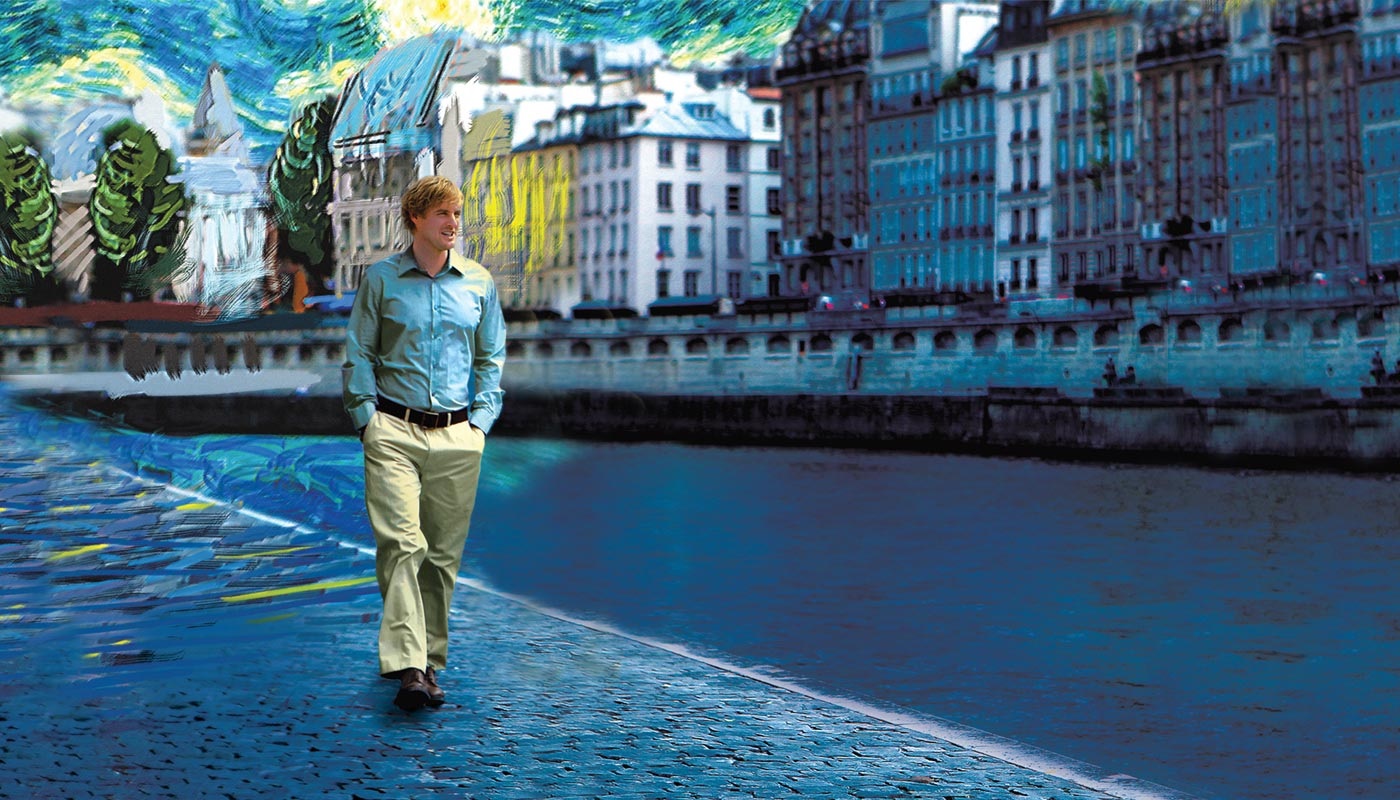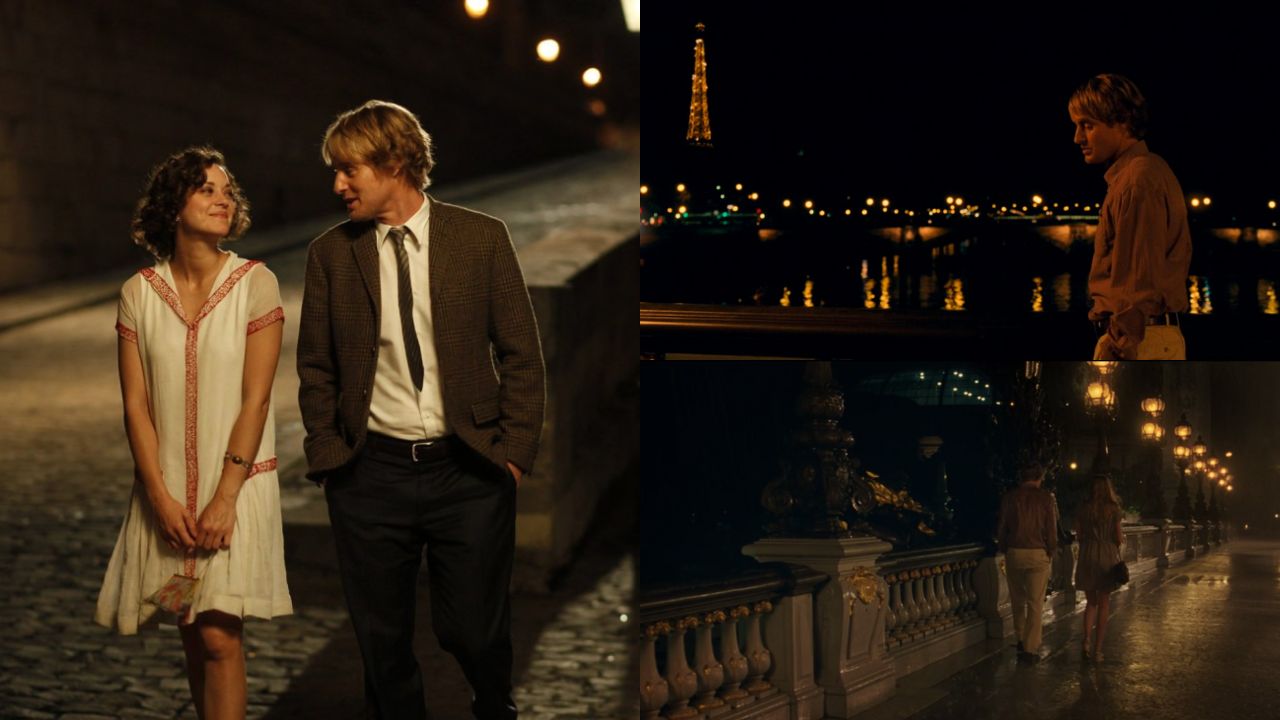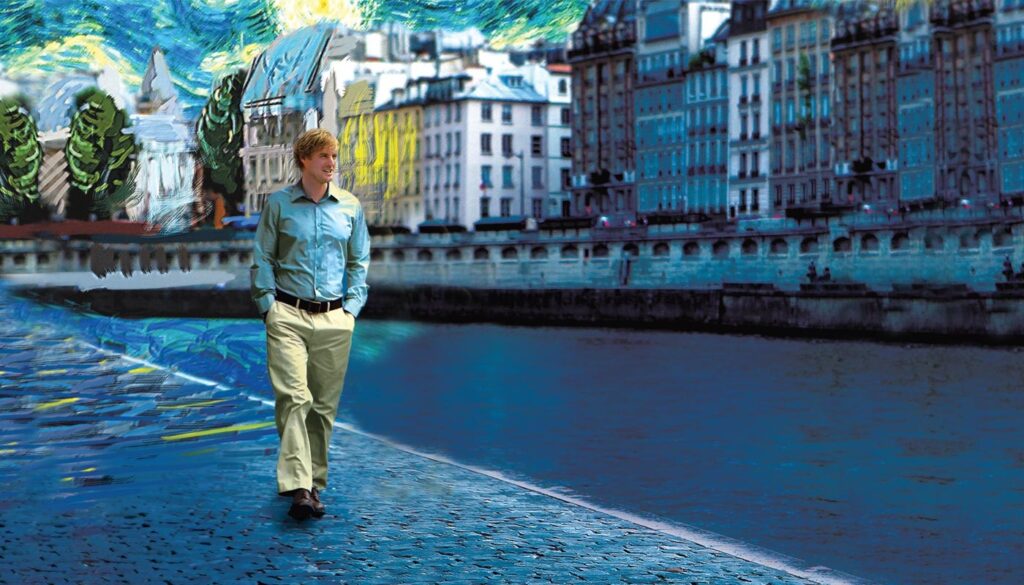This post includes a brief plot summary and an explanation about the ending of the 2011 film “Midnight in Paris“. Beware of spoilers.
Directed by Woody Allen, the 2011 fantasy comedy stars Owen Wilson as Gil Pender and Marion Cotillard as Adriana.

Midnight in Paris tells the story of a Hollywood screenwriter (Gil) who dreams about moving to Paris. His fiancée (Inez) does not share the same excitement about the City of Lights and often brushes him off. After a casual night out with Inez’s friends, Gil decides to wander the streets of Paris all by himself. At midnight, a 1920s car stops by, and the passengers (also dressed accordingly) rush Gil to join in. The screenwriter accepts the ride and joins them.
What Is Going On in “Midnight in Paris”? (Plot Explained)
Every time the clock hits midnight, a car will stop by, taking Gil back to the past: the 1920s to be more precise. However, the time travels in this story are not one-way stops, they are more like round trips. In other words, Gil gets to travel back and forth between the 1920s and the present.
During his time travels, Gil meets several influential figures, such as Ernest Hemingway, Gertrude Stein and even Picasso. There is also a woman who catches his attention, Adriana (Picasso’s lover). Over time, Gil and Adriana grow closer. The attraction he feels for this woman brings him great conflict, as he is still engaged to Inez at this point.
In Midnight in Paris, past and present are somehow connected. For instance, during a random daytime walk along the Seine, Gil finds Adriana’s diary at a book stall. While reading, Gil finds that his attraction to Adriana is not one-sided, as a matter of fact, it’s mutual.
During his next time travel, Gil gets some alone time with Adriana and they kiss. However, a carriage stops by and interrupts their romantic moment. A couple invites Gil and Adriana to join them. They are all transported to the Belle Époque, Adriana’s golden age.
In the presence of prominent figures, Gil asks them what they thought the best era was, and they all answer: the Renaissance. Meanwhile, Adriana gets a job offer and asks Gil to stay. After carefully pondering Adriana’s request, Gil decides to leave the Belle Époque and they part ways.
The Ending of “Midnight in Paris” Explained
The ending of “Midnight in Paris” shows Gil leaving his fiancée and moving to Paris. During a random walk along the Seine, Gil bumps into a familiar face (Gabrielle). Shortly after, it starts to rain, and Gil offers to walk Gabrielle home. While talking, they both learn about their mutual love for Paris in the rain.
Why did Gil leave Adriana?
Gil leaves Adriana in Midnight in Paris because the Belle Époque was not his “golden age”. Also, Gil comes to the following realization: everyone has a different “golden age”.
The allure of nostalgia is based on a romanticized idea of the past. Having said that, any time can become dull if we don’t embrace it. Therefore, he ceases to find happiness in the past. As a result, Gil decides to leave Adriana and also stop time-travelling to the 1920s.

How did Gil find out that Inez was cheating on him?
Gertrude Stein’s comment was the final nail in the coffin that put Gil and Inez’s relationship to an end. During his last trip to the 1920s, Gil shows the writer the first two chapters of his novel. At the time, Gertrude praised his progress but also raised questions about the main character. In particular, how clueless the man is regarding his fiancée’s infidelity.
After listening to Gertrude’s words, Gil returns to the present and confronts Inez. The young woman doesn’t even try to deny the affair. Instead, Inez chooses to brush off the situation by telling Gil that it was only a fling. Without a reason to stay, Gil decides to break off the engagement with Inez.
Who is the girl at the end of Midnight in Paris?
The girl Gil bumps into at the end of Midnight in Paris is Gabrielle. She is the French lady who sold the gramophone that he bought earlier while walking along the Seine. Gil met Gabrielle the same day, he found Adriana’s diary at a book stall.
Discussion about Nostalgia in “Midnight in Paris”
What is “Midnight in Paris” about? The film is mainly about nostalgia and escapism. As Paul puts it: “Nostalgia is denial. Denial of the painful present.” People tend to romanticize the past because they have difficulty coping with the present. Having said that, the time-travelling in the film is a metaphor for escapism. What led Gil to enter that car full of strangers? At the moment, he wanted to escape from his “dull” present.
Soon, Gil finds out that escaping to a different past is not the solution to whatever he is looking for. Therefore, he decides to leave Adriana in La Belle Époque. Not only that, but Gil also stops his time travels to the 1920s. Towards the end of his journey, Gil realizes that one should embrace what the present has to offer instead of romanticizing the past.

Final Thoughts
Whether you are a Woody Allen fan or not, you can’t deny the impeccable aesthetics of his films. The plot of “Midnight in Paris” is pretty surreal. A lot of things don’t make sense. However, that’s what makes a good Woody Allen film.
Is “Midnight in Paris” fantasy or reality? Well, it depends. If you take it literally, then yes, time travel happens in the film. Gil really meets all those famous figures presented in the film. However, the whole film could also be read as a dream. All those encounters could be manifestations of Gil’s conscience. After all, he’s trying to learn more about himself and confront parts of himself that he doesn’t want to deal with (i.e., Inez cheating on him).
Having said that, there’s no real logic behind a film like “Midnight in Paris”. However, if you are able to get over the time travelling aspect of the film, you’ll find Midnight In Paris quite magical. Nostalgia is definitely the recurrent theme of the film. Gil is living in the present, but he’s fantasizing about the past. Throughout the film, you realize that everyone romanticizes the past.
Personally, I don’t think there is anything wrong with looking at the past through rose-tinted glasses. It’s all about perception. Escapism is in many ways, one’s personal power to manipulate reality. If romanticizing the past can bring momentary joy, then what’s wrong with that? I believe the key to all of this is to also learn how to create happy moments and cherish the present, which is perhaps, the main message of “Midnight in Paris”.
Overall, “Midnight in Paris” is an unforgettable visual experience. That’s why I enjoy Woody Allen’s films. As I was watching it, I felt like I was there. Though I wasn’t feeling too empathetic about Gil’s character, I understood his motivations. All the other characters felt a bit one-dimensional, except Adriana. Unlike Inez, it’s harder to pin-point who or what Adriana really is. In addition, the cameos were just precious to watch. I mean, where else will you ever find Ernest Hemingway and F. Scott Fitzgerald in the same scene? Priceless.


